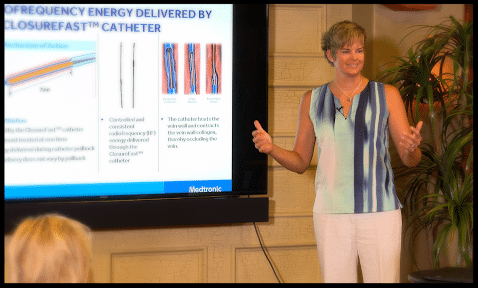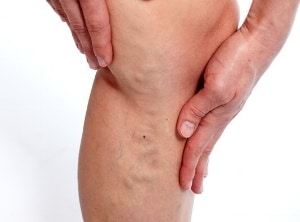What is endovenous ablation?

Endovenous Ablation Definition
Taken literally, endovenous ablation is the removal of a vein from within. ‘Endo’ means internal or inside, ‘venous’ refers to a vein, and ablation is to ‘remove’.
In the instance of veins, it is no longer necessary to physically remove a vein from the leg (vein stripping) to improve symptoms or the condition of chronic venous insufficiency. Technology exists in which the vein can be treated or ablated utilizing different forms of ablation.
Endovenous Vein Ablation Techniques
The three endovenous techniques which are currently used are; chemical closure (sclerotherapy), thermal closure (endovenous radiofrequency ablation or endovenous laser vein ablation), and the newest method is adhesive closure VenaSeal, a non tumescent non thermal vein closure. All three techniques close the veins off by accessing them with needle puncture and damaging the vein from the inside. By inflicting damage to the inside of the vein with either sclerosant, heat energy or adhesive, the veins are permanently closed and over time the body breaks this tissue down and carries it away.
The most common technique associated with the term endovenous ablation is the thermal technique. While inside the vein with either radiofrequency or laser energy, the vein is closed utilizing the thermal or heat energy delivered by the device. This technique requires an initial venous consultation and duplex ultrasound. It is also the technique recognized by most insurance companies and is indicated for treatment of symptomatic venous insufficiency in patients who have failed conservative therapy such as compression stocking use.
Next Steps?
If you are interested in obtaining more information about venous disease and symptoms which are causing you or a loved one concern, please consult a board certified Vein Specialist for a full exam and Duplex Ultrasound. Together with a medical professional you can discuss the most effective treatment for your specific situation.
Is there anything worse than itchy varicose veins? Maybe, but itchy veins remains high on the list of issues we would love to resolve before they drive us crazy. If you are experiencing itching around your varicose veins, it could be a message from your body that it is time to have your veins checked…
Read MoreThe full story on Chronic Venous Insufficiency, what it is and how to treat it. A video presentation by Jilanne Rose, DNP-C, Clinical Director. Run Time 24:46. TRANSCRIPT What’s the Difference Between Veins and Arteries? When we talk about vascular health and vascular disease most people think about arteries. When we talk about the…
Read MoreA group of Gilbert Arizona Residents concerned about Chronic Venous Insufficiency gathered on Saturday July 16th for an interactive discussion on CVI symptoms, causes and treatments. Chronic Venous Insufficiency, Venous Reflux Disease and Varicose Veins affect over 30 million American men and women. Unfortunately, many do not get treated as they believe varicose veins are…
Read MoreCan Chronic Venous Insufficiency (CVI) be reversed? Unfortunately the short answer to this question is no; but CVI can be treated with minimally invasive procedures which can reduce symptoms and improve quality of life tremendously! Chronic Vein Insufficiency Causes In order to understand why venous insufficiency or peripheral venous insufficiency cannot be reversed, we must…
Read MoreWhat can you do to treat bleeding varicose vein and spider veins? First and foremost, don’t panic. Although the visual effect of a ruptured varicose vein or bleeding vein can be alarming, there are some simple things that can be done to get the bleeding to stop. If you can reach the area that is…
Read MoreWhy are varicose veins painful? The discomfort associated with varicose veins is caused by a combination of factors. When veins are weak, the blood which is supposed to return to the heart in a timely fashion, settles and pools in the superficial vein system. This pooling of blood worsens when patients stand or sit in…
Read MoreEndovenous Ablation Definition Taken literally, endovenous ablation is the removal of a vein from within. ‘Endo’ means internal or inside, ‘venous’ refers to a vein, and ablation is to ‘remove’. In the instance of veins, it is no longer necessary to physically remove a vein from the leg (vein stripping) to improve symptoms or the…
Read MoreThe newest procedure for the treatment of varicose veins was approved by the FDA about two years ago. It is what has been termed a non-tumescent non-thermal therapy. What this means is that it does not require a lot of numbing medicine to complete, and it does not use a heating element to close or…
Read MoreWhat is the best treatment for varicose veins? No varicose vein is the same; no person’s symptoms are the same; and so the best procedure for varicose veins is not always the same. The treatments associated with vein disease are based on a patient’s symptoms, vein size, location, contributing conditions, and ultrasound findings. Different…
Read More

